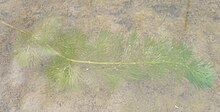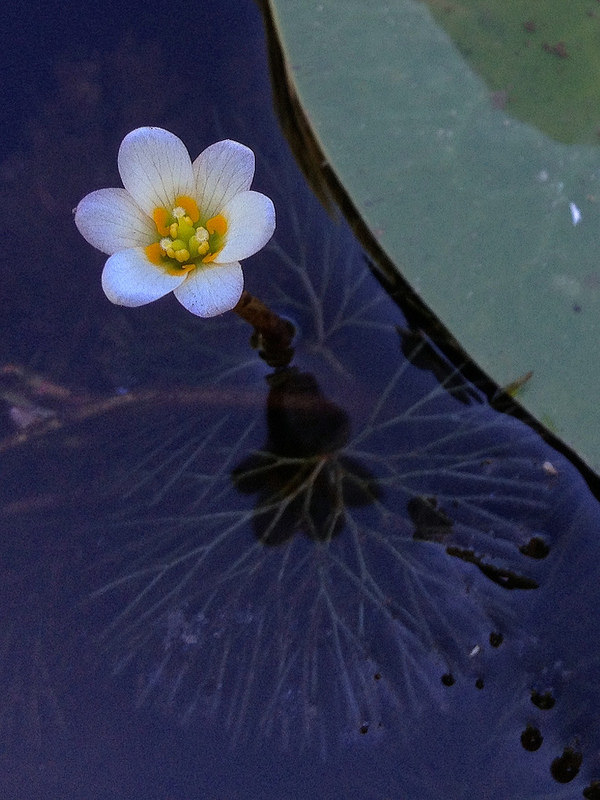Map Snapshot





10 Records
Status
Carolina Fanwort is an invasive species in Maryland (MISC 2022).
Seasonality Snapshot
Source: Wikipedia
| Cabomba caroliniana | |
|---|---|

| |
| Scientific classification | |
| Kingdom: | Plantae |
| Clade: | Tracheophytes |
| Clade: | Angiosperms |
| Order: | Nymphaeales |
| Family: | Cabombaceae |
| Genus: | Cabomba |
| Species: | C. caroliniana
|
| Binomial name | |
| Cabomba caroliniana | |
Cabomba caroliniana, commonly known as Carolina fanwort and various other names, is an aquatic perennial herbaceous plant native to North and South America. Having been a popular aquarium plant, it has been exported around the world, and has become an invasive species in Europe and Australia.
Common names
[edit]Cabomba caroliniana is commonly called Carolina fanwort,[2] Carolina water shield,[3] green cabomba, fanwort, fish grass, Washington grass, Washington plant, common cabomba, Washington plant, and watershield.[4]
Distribution
[edit]It is native to southeastern South America (southern Brazil, Paraguay, Uruguay, and northeastern Argentina),[5] and the East and West Coasts of the United States.[2] It is eaten as a vegetable in some areas.
Description
[edit]
Fanwort is a submerged, sometimes floating, but often rooted, freshwater perennial plant with short, fragile rhizomes. The erect shoots are upturned extensions of the horizontal rhizomes. The shoots are grass-green to olive-green or sometimes reddish-brown. The leaves are of two types: submerged and floating. The submerged leaves are finely divided and arranged in pairs on the stem. The floating leaves, when present, are linear and inconspicuous, with an alternate arrangement. They are less than 1⁄2 in (13 mm) long and narrow (less than 1⁄4 in or 6.4 mm). The leaf blade attaches to the centre, where a slight constriction is seen. The flowers are white and small (less than 1⁄2 in (13 mm) in diameter) and are on stalks that arise from the tips of the stems.
-
Green and reddish-brown shoots
-
Straplike floating leaves with flowers
-
Finely-divided submerged leaves
-
Submerged leaves protruding above the surface
-
Flowers
-
Infested area in flower (larger round leaves are another species)
Cytology
[edit]The chloroplast genome of Cabomba caroliniana is 164057 bp or 160177 bp long.[6]
Ecological aspects
[edit]Large numbers of plants are sent from Florida to the rest of the U.S. for commercial use. Fanwort is also grown commercially in Asia for export to Europe and other parts of the world. Small-scale, local cultivation occurs in some areas, and aquarists are probably responsible for some introductions.[citation needed]
This species grows rooted in the mud of stagnant to slow-flowing water, including streams, smaller rivers, lakes, ponds, sloughs, and ditches. In some states in the United States, it is now regarded as a weed. Fanwort stems become brittle in late summer, which causes the plant to break apart, facilitating its distribution and invasion of new water bodies. It produces by seed, but vegetative reproduction seems to be its main vehicle for spreading to new waters. Growth of 50 mm (2.0 in) a day has been reported in Lake Macdonald in Queensland, Australia.[7]
Use in the aquarium trade has led to some species being introduced to other parts of the world, such as Australia, where Cabomba caroliniana it is a nationally declared weed.[8] Having arrived in 1967, it spread rapidly in waterways and out-competed native plants, threatening water supplies, especially along the eastern side of the continent.[9] It is a weed of national significance in Australia.[10]
It is also on the list of invasive alien species of union concern in the EU.[11] The latter implies that the species cannot be traded nor commercialised. The EU forbids trading and selling of the plant and requires people possessing it before the Regulation went into force to take appropriate measures to prevent it from spreading.[12]
Control measures
[edit]As of July 2023[update] a trial is under way to control the weed by introducing a tiny South American beetle, Hydrotimetes natans, or Cabomba weevil, into Lake Macdonald and Lake Kurwongbah in Queensland. The species is being bred in a nursery at Lake Kurwongbah, with a view to national introduction for biological control of the weed. The larvae of the weevil damage the plant by tunnelling through its stems, breaking them down and causing secondary infections which hinder their ability to reproduce. Testing has been stringent, and it has been found that only the insect only feeds on cabomba, and does not affect any native plants.[9]
Conservattion
[edit]The NatureServe conservation status is G5 Secure.[1]
References
[edit]- ^ a b Cabomba caroliniana. (n.d.). NatureServe. Retrieved November 21, 2024, from https://explorer.natureserve.org/Taxon/ELEMENT_GLOBAL.2.146971/Cabomba_caroliniana
- ^ a b NRCS. "Cabomba caroliniana". PLANTS Database. United States Department of Agriculture (USDA). Retrieved 10 January 2016.
- ^ BSBI List 2007 (xls). Botanical Society of Britain and Ireland. Archived from the original (xls) on 26 June 2015. Retrieved 17 October 2014.
- ^ "Cabomba". Brisbane City Council - Weed Identification Tool. 31 December 2021. Retrieved 13 July 2023.
- ^ Department of Ecology, Washington State: Cabomba caroliniana Archived 2016-10-14 at the Wayback Machine. Non-Native Invasive Freshwater Plants. Retrieved 16 August 2016
- ^ Gruenstaeudl, M., Gerschler, N., & Borsch, T. (2018). Bioinformatic workflows for generating complete plastid genome sequences—an example from Cabomba (Cabombaceae) in the context of the phylogenomic analysis of the water-lily clade. Life, 8(3), 25.
- ^ "Cabomba caroliniana". Global Invasive Species Database. 4 March 2006. Retrieved 13 July 2023.
Principal source: Washington State Department of Ecology, 2003. Technical Information About Cabomba Caroliniana (Fanwort), ERDC, UNDATED Cabomba caroliniana Gray (Fanwort); Compiler: National Biological Information Infrastructure (NBII) & IUCN/SSC Invasive Species Specialist Group (ISSG)
- ^ "Cabomba (Cabomba caroliniana)". NSW WeedWise. 24 January 2020. Retrieved 13 July 2023.
- ^ a b Nichols, Jennifer (10 July 2023). "Cabomba weevil unleashed on weed-infesting Australian waterways". ABC News (Australia). Retrieved 12 July 2023.
- ^ "Weeds Australia - Weeds of National Significance". Archived from the original on 17 October 2008. Retrieved 4 October 2008.
- ^ "Annex to the commission implementing regulation (EU)... adopting a list of invasive alien species of Union concern pursuant to Regulation (EU); No 1143/2014 of the European Parliament and of the Council: List of invasive alien species of Union concern" (PDF). Archived from the original (PDF) on 13 July 2016. Retrieved 14 July 2016.
- ^ "European Regulation IAS". June 2021. Archived from the original on 10 September 2015.
Further reading
[edit]- Ørgaard, M. (1991). The genus Cabomba (Cabombaceae) - a taxonomic study. Nordic Journal of Botany 11: 179-203
- Gleason, H.A. and A. Cronquist. 1991. Manual of Vascular Plants of Northeastern United States and Adjacent Canada. The New York Botanical Garden, Bronx, New York.
- Hotchkiss, N. 1972. Common Marsh, Underwater and Floating-leaved Plants of the United States and Canada. Dover Publications, Inc., New York.
- Radford, A.E., H.E. Ahles, and C.R. Bell. 1968. Vascular Flora of the Carolinas. The University of North Carolina Press, Chapel Hill.
- Riemer, D.N. and R.D. Ilnicki. 1968. Overwintering of Cabomba in New Jersey. Weed Science 16:101-102.








